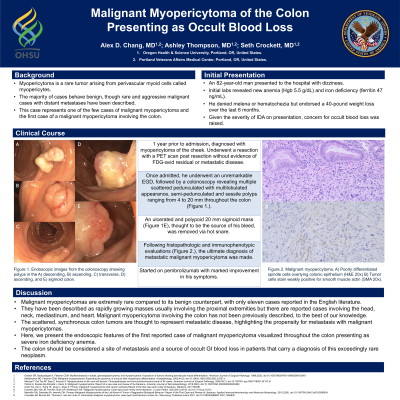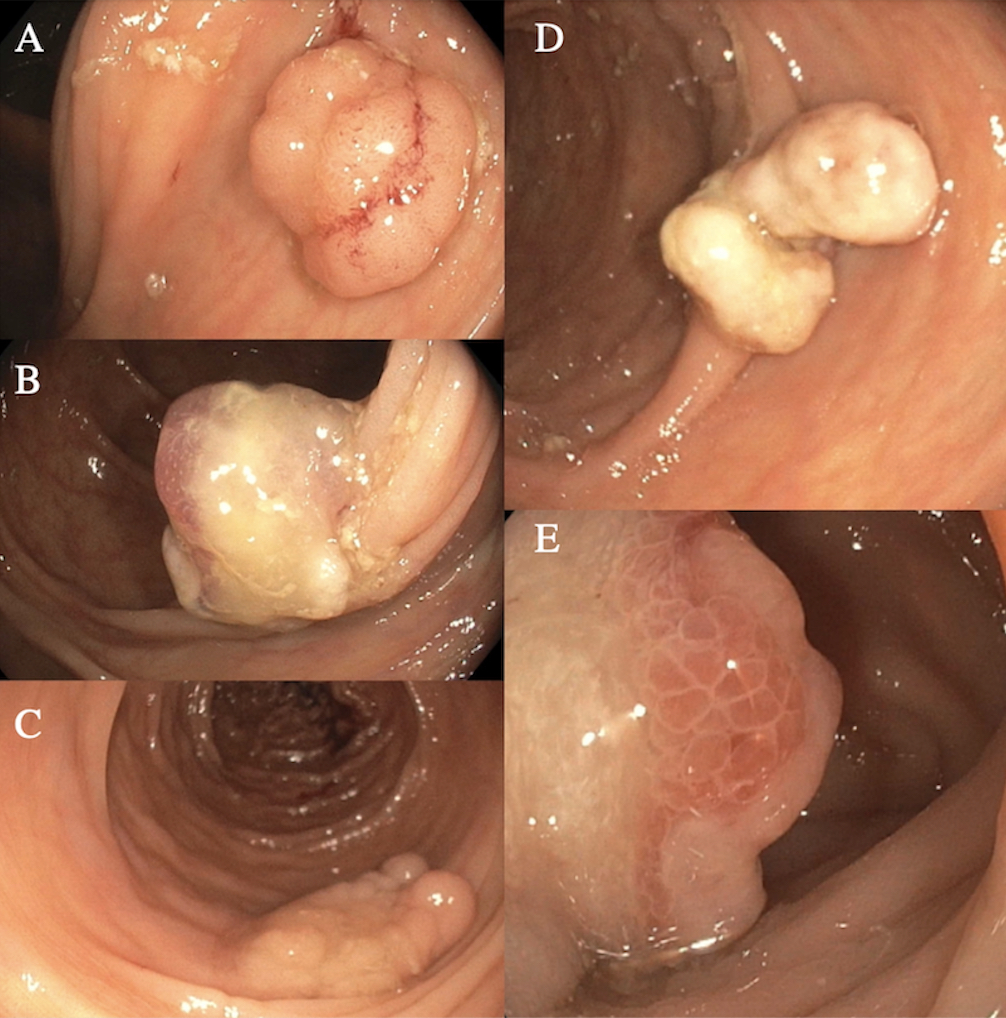Monday Poster Session
Category: Colon
P2087 - Malignant Myopericytoma Involving the Colon Presenting as Occult Blood Loss
Monday, October 28, 2024
10:30 AM - 4:00 PM ET
Location: Exhibit Hall E

Has Audio
- AC
Alex D. Chang, MD
Oregon Health & Science University
Portland, OR
Presenting Author(s)
Award: Presidential Poster Award
Alex D. Chang, MD, Ashley Thompson, MD, Seth Crockett, MD
Oregon Health & Science University, Portland, OR
Introduction: Myopericytoma is a rare tumor arising from perivascular myoid cells called myopericytes. Histologically, they are composed of oval/myoid-appearing spindle cells. Most cases are benign, though rare and aggressive malignant cases with distant metastases have been described. Here we report a case of malignant myopericytoma involving the colon presenting as an occult GI bleed—this represents one of the few cases of malignant myopericytoma and the first case of a malignant myopericytoma involving the colon.
Case Description/Methods: An 82-year-old man presented with dizziness. Initial labs revealed new iron deficiency anemia (IDA) (Hgb 5.5 g/dL). He denied melena/hematochezia but endorsed a 40-pound weight loss. His vitals remained stable with unremarkable abdominal/rectal exams. Given the severity of IDA, concern for occult blood loss was raised. He underwent an unremarkable upper endoscopy, followed by a colonoscopy that revealed multiple scattered, multilobulated, pedunculated, semi-pedunculated and sessile polyps ranging from 4 to 20 mm throughout the colon (Figure 1). An ulcerated and polypoid 20 mm sigmoid mass (Figure 1E), thought to be the source of his bleed, was removed via hot snare. Following histopathologic and immunophenotypic evaluation, the ultimate diagnosis of metastatic malignant myopericytoma was made and he was started on pembrolizumab.
The patient had been diagnosed with myopericytoma of his cheek one year prior. It was resected with positive deep margins requiring subsequent resection, and a PET scan post resection revealed no evidence of FDG-avid residual or metastatic disease.
Discussion: Malignant myopericytomas are extremely rare compared to its benign counterpart, with only eleven cases reported in the English literature. They have been described as rapidly growing masses usually involving the proximal extremities but there are reported cases involving the head, neck, mediastinum, and heart. Malignant myopericytoma involving the colon has not been previously described, to the best of our knowledge. The scattered, synchronous colon tumors are thought to represent metastatic disease, highlighting the propensity for metastasis with malignant myopericytomas.
In summary, we present the endoscopic features of the first reported case of malignant myopericytoma visualized throughout the colon presenting as severe IDA. The colon should be considered a site of metastasis and a source of occult GI blood loss in patients that carry a diagnosis of this exceedingly rare neoplasm.

Disclosures:
Alex D. Chang, MD, Ashley Thompson, MD, Seth Crockett, MD. P2087 - Malignant Myopericytoma Involving the Colon Presenting as Occult Blood Loss, ACG 2024 Annual Scientific Meeting Abstracts. Philadelphia, PA: American College of Gastroenterology.
Alex D. Chang, MD, Ashley Thompson, MD, Seth Crockett, MD
Oregon Health & Science University, Portland, OR
Introduction: Myopericytoma is a rare tumor arising from perivascular myoid cells called myopericytes. Histologically, they are composed of oval/myoid-appearing spindle cells. Most cases are benign, though rare and aggressive malignant cases with distant metastases have been described. Here we report a case of malignant myopericytoma involving the colon presenting as an occult GI bleed—this represents one of the few cases of malignant myopericytoma and the first case of a malignant myopericytoma involving the colon.
Case Description/Methods: An 82-year-old man presented with dizziness. Initial labs revealed new iron deficiency anemia (IDA) (Hgb 5.5 g/dL). He denied melena/hematochezia but endorsed a 40-pound weight loss. His vitals remained stable with unremarkable abdominal/rectal exams. Given the severity of IDA, concern for occult blood loss was raised. He underwent an unremarkable upper endoscopy, followed by a colonoscopy that revealed multiple scattered, multilobulated, pedunculated, semi-pedunculated and sessile polyps ranging from 4 to 20 mm throughout the colon (Figure 1). An ulcerated and polypoid 20 mm sigmoid mass (Figure 1E), thought to be the source of his bleed, was removed via hot snare. Following histopathologic and immunophenotypic evaluation, the ultimate diagnosis of metastatic malignant myopericytoma was made and he was started on pembrolizumab.
The patient had been diagnosed with myopericytoma of his cheek one year prior. It was resected with positive deep margins requiring subsequent resection, and a PET scan post resection revealed no evidence of FDG-avid residual or metastatic disease.
Discussion: Malignant myopericytomas are extremely rare compared to its benign counterpart, with only eleven cases reported in the English literature. They have been described as rapidly growing masses usually involving the proximal extremities but there are reported cases involving the head, neck, mediastinum, and heart. Malignant myopericytoma involving the colon has not been previously described, to the best of our knowledge. The scattered, synchronous colon tumors are thought to represent metastatic disease, highlighting the propensity for metastasis with malignant myopericytomas.
In summary, we present the endoscopic features of the first reported case of malignant myopericytoma visualized throughout the colon presenting as severe IDA. The colon should be considered a site of metastasis and a source of occult GI blood loss in patients that carry a diagnosis of this exceedingly rare neoplasm.

Figure: Figure 1. Endoscopic images from the colonoscopy showing pedunculated, semi-pedunculated, polypoid and sessile tumors in the A, B) ascending, C) transverse, D) descending, and E) sigmoid colon.
Disclosures:
Alex Chang indicated no relevant financial relationships.
Ashley Thompson indicated no relevant financial relationships.
Seth Crockett indicated no relevant financial relationships.
Alex D. Chang, MD, Ashley Thompson, MD, Seth Crockett, MD. P2087 - Malignant Myopericytoma Involving the Colon Presenting as Occult Blood Loss, ACG 2024 Annual Scientific Meeting Abstracts. Philadelphia, PA: American College of Gastroenterology.

